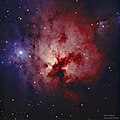astro.wikisort.org - Galaxy
NGC 1579 (also known as the Northern Trifid) is a diffuse nebula located in the constellation of Perseus. It is referred to as the Northern Trifid because of its similar appearance to the Trifid Nebula, which is located in the southern celestial hemisphere of the sky. It is a H II region, a region of star formation.[4]
| Emission nebula | |
|---|---|
| H II region | |
 NGC 1579 (Northern Trifid), as captured with the Hubble Space Telescope | |
| Observation data: J2000 epoch | |
| Right ascension | 04h 30m 09.5s[1] |
| Declination | +35° 16′ 19″[1] |
| Apparent dimensions (V) | 12' × 8'[2] |
| Constellation | Perseus[3] |
| Physical characteristics | |
| Radius | 4 ly |
| Designations | LBN 767, [B77] 70, Ced 35, LBN 165.38-08.73, [SS62] 19, DG 34, SH 2-222, [TP72] 12. |
The star cluster contains the emission-line star LkHα 101, which provides much of the ionizing radiation in the nebula.[5]
NGC 1579 lies within a giant molecular cloud known as the California Molecular Cloud.[6]
Gallery
- Wide field image of NGC 1579 from the 0.8m Schulman Telescope at the Mount Lemmon SkyCenter
- HaRGB image of the Northern Trifid Nebula NGC 1579 from the Liverpool Telescope on La Palma
References
- "NGC 1579". SIMBAD. Centre de données astronomiques de Strasbourg. Retrieved 2013-06-04.
- Seligman, Courtney. "Celestial Atlas: NGC Objects: NGC 1550 - 1599". cseligman.com. Archived from the original on 15 March 2015. Retrieved 11 July 2015.
- "NGC 1579". Search results for NGC 1579. Wikisky. Retrieved 5 June 2013.
- "A Hubble View of NGC 1579: The Trifid of the North". 7 Jun 2013. Retrieved 9 Jun 2013.
- GH Herbig (2004). "LkHα 101 and the Young Cluster in NGC 1579". Astronomical Journal. 128 (3): 1233–1253. Bibcode:2004AJ....128.1233H. doi:10.1086/423043.
- Lada, Charles J.; Lombardi, Marco; Alves, João (2009). "The California Molecular Cloud". Astronomical Journal. 703 (1): 52–59. arXiv:0908.0646. Bibcode:2009ApJ...703...52L. doi:10.1088/0004-637X/703/1/52.
External links
 Media related to NGC 1579 at Wikimedia Commons
Media related to NGC 1579 at Wikimedia Commons
На других языках
[de] NGC 1579
NGC 1579 ist ein diffuser Nebel im Sternbild Perseus am Nordsternhimmel, der wegen seiner Ähnlichkeit zum Trifidnebel auch als "Trifid des Nordens" bezeichnet wird. Der Nebel resultiert aus einer 2600 Lichtjahre entfernten HII-Region, die von einem sehr hellen Stern (LkHα 101) beleuchtet wird.- [en] NGC 1579
[ru] NGC 1579
NGC 1579 (другое обозначение — LBN 766) — диффузная туманность в созвездии Персей.Текст в блоке "Читать" взят с сайта "Википедия" и доступен по лицензии Creative Commons Attribution-ShareAlike; в отдельных случаях могут действовать дополнительные условия.
Другой контент может иметь иную лицензию. Перед использованием материалов сайта WikiSort.org внимательно изучите правила лицензирования конкретных элементов наполнения сайта.
Другой контент может иметь иную лицензию. Перед использованием материалов сайта WikiSort.org внимательно изучите правила лицензирования конкретных элементов наполнения сайта.
2019-2025
WikiSort.org - проект по пересортировке и дополнению контента Википедии
WikiSort.org - проект по пересортировке и дополнению контента Википедии

